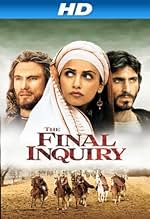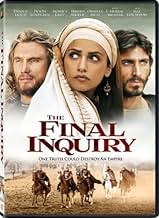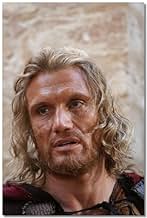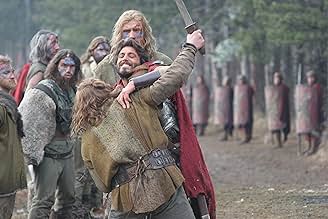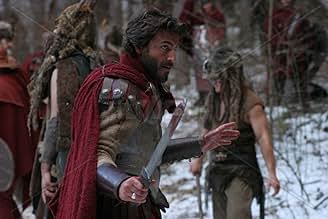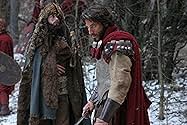IMDb-BEWERTUNG
5,2/10
1472
IHRE BEWERTUNG
Füge eine Handlung in deiner Sprache hinzuIn 35 A.D., a Roman tribune is sent to Palestine to investigate the death and possible resurrection of a certain Jesus from Nasareth.In 35 A.D., a Roman tribune is sent to Palestine to investigate the death and possible resurrection of a certain Jesus from Nasareth.In 35 A.D., a Roman tribune is sent to Palestine to investigate the death and possible resurrection of a certain Jesus from Nasareth.
- Auszeichnungen
- 2 wins total
Empfohlene Bewertungen
I want to comment on what someone already said.
The comment was upset at treatment of Jewish practice portrayed in the film. However, the rules on adultery and trials, well ... if you want to be upset, be upset at the gospels.
The gospels portrayed the trial as a crooked rush job. Likewise, the stoning for adultery (and in the past, rural areas did not always strictly follow the dictates of the law) was referenced in a favorite scene in the Bible as well. The Bible had no "backstory" underlining that really the stoning in practice was a last result and rarely done practice. We were meant to see it as barbaric, the crowd driven more by passion than reason (before Jesus came around to guilt them).
In fact, some gospels had various scenes that put Jewish practice in bad light. At times unfairly. For instance, the money-changing in the temple -- you needed that to allow people from all over to have the right sort of coin to give their offering. It surely had some bad flavor, but it was not just about a "band of thieves." Lashing out like Jesus did kinda suggests why some thought the guy a tad bit dangerous especially in an age of rebels and revolts.
If one wants a "historical" reflection of what "actually" happened, which honestly would be not a bad way to go, they wouldn't be as reliant on scripture and all. The conceit of this movie also would not really be possible, to be totally honest about it.
The comment was upset at treatment of Jewish practice portrayed in the film. However, the rules on adultery and trials, well ... if you want to be upset, be upset at the gospels.
The gospels portrayed the trial as a crooked rush job. Likewise, the stoning for adultery (and in the past, rural areas did not always strictly follow the dictates of the law) was referenced in a favorite scene in the Bible as well. The Bible had no "backstory" underlining that really the stoning in practice was a last result and rarely done practice. We were meant to see it as barbaric, the crowd driven more by passion than reason (before Jesus came around to guilt them).
In fact, some gospels had various scenes that put Jewish practice in bad light. At times unfairly. For instance, the money-changing in the temple -- you needed that to allow people from all over to have the right sort of coin to give their offering. It surely had some bad flavor, but it was not just about a "band of thieves." Lashing out like Jesus did kinda suggests why some thought the guy a tad bit dangerous especially in an age of rebels and revolts.
If one wants a "historical" reflection of what "actually" happened, which honestly would be not a bad way to go, they wouldn't be as reliant on scripture and all. The conceit of this movie also would not really be possible, to be totally honest about it.
If you enjoy Biblical film, you should enjoy this and add it to your collection. I'm not sorry I purchased it. Lundgren & Liotti are fabulous to look at and Monica Cruz is no slouch either (she looks just like her sister, Penelope).
The story-line is great. I wonder where the "Goofs" section is under "Fun Stuff" on IMDb, as this film was not devoid of them. For example, the rolling away of the massive stone at the tomb of Lazarus. It was done by one guy while another stood with a piece of lumber to assist by prying it but really did nothing, which would not have been possible. Some of the fight scenes just looked very badly done. There was a kiss scene wherein saliva strung from one person to another that would have been much more watchable had that been edited out. Finally, at the end, the terrain was striped by tire tracks and what looked like a radio tower on a mountain top.
The story-line is great. I wonder where the "Goofs" section is under "Fun Stuff" on IMDb, as this film was not devoid of them. For example, the rolling away of the massive stone at the tomb of Lazarus. It was done by one guy while another stood with a piece of lumber to assist by prying it but really did nothing, which would not have been possible. Some of the fight scenes just looked very badly done. There was a kiss scene wherein saliva strung from one person to another that would have been much more watchable had that been edited out. Finally, at the end, the terrain was striped by tire tracks and what looked like a radio tower on a mountain top.
I saw the brilliant original by Damiano Damiani (http://www.imdb.com/title/tt0093255/) about twenty years ago. This is not a remake. Compared to the original screenplay, the story in this film is a joke in the best tradition of Hollywood, and it utterly does not follow the original plot.
This is a propaganda movie, a failed copy of the masterpiece by Damiano Damiani and a poor attempt to substitute real world values by thin air speculation and candy, pure Hollywood style. Nevertheless the movie has a value of its own, I have never seen Dolf Lundgren in a role like the one he took in this movie, and I could say that Monica Cruz play is not worse than her sister's, not to mention that Monica is somehow prettier than Penelope. It is a shame that Ornella Mutti did not participate in the original by her compatriot Damiano Damiani.
This is a propaganda movie, a failed copy of the masterpiece by Damiano Damiani and a poor attempt to substitute real world values by thin air speculation and candy, pure Hollywood style. Nevertheless the movie has a value of its own, I have never seen Dolf Lundgren in a role like the one he took in this movie, and I could say that Monica Cruz play is not worse than her sister's, not to mention that Monica is somehow prettier than Penelope. It is a shame that Ornella Mutti did not participate in the original by her compatriot Damiano Damiani.
In 35 A.D. , an overconfident Roman tribune named Tito Valerio (Daniel Liotti) is sent to a remote part of the empire called Palestine to on a bizarre investigation to discover the death and possible resurrection of a certain Jesus from Nazareth , only to attract the suspicion of the local governor Pontius Pilate (Shopov) . This is the thrilling tale of one man's quest accompanied by a hunk barbarian slave (Dolph Lundgren) to uncover the mystery of all mysteries and while an official cover-up is presumed . A Roman agent is sent by emperor Tiberio (Max Von Sydow) to Palestine to investigate rumors of the resurrection of an executed criminal . Sent to disprove the resurrection and on a spiritual quest , he discovers faith , love (to Monica Cruz who looks exactly like Penelope as physical as acting) and a revelation that could shatter the empire . The tribune is taken prisoner and submitted a set-up .
Interesting story treating the resurrection of Jesus Christ with intrigue , suspense , a love story and adding historical events . As appears several historic characters as Tiberius , Caligula , Pontius Pilate , Apostle Peter finely performed by Enrico Lo Verso , Saulus of Tarsus well played by Fernando Guillen Cuervo , Maria mother of Jesus and Maria Magdalena in a brief acting by Ornella Muti . I found the film's motif a timeless subject , engaging and handled very skillfully too . Being conceived as both a theatrical film and a TV movie and treatment by the famous author of best-sellers about ancient world named Valerio Manfredini . The story from Suso Cecchi D'Amico and Ennio Flaiano even had an exclusive one-week theatrical engagement in Dallas , Texas . It's an acceptable treatment of the political and religious thought-world of the time , convincingly developed and the intent of the filmmakers is ultimately both ambitious and entertaining . The biggest weakness of the movie is the acting . Daniel Liotti as hard-nosed investigator and Dolph Lundgren as bouncing illiterate both deliver some stiff line-readings . But Liotti ultimately rises to the occasion , especially in the crucial last half-hour . Max Von Sidow is a credible emperor Tiberio who sends Daniel Liotti off on a dangerous mission . The picture has a Christian point of view that holds interest , while the former adaptation had offbeat and ambiguous resolution . The production was supported of a 500,000 Euros grant from the European Council fund Eurimages . It's an European co-production among various countries but specially Italy and Spain by producer Enrique Cerezo . Atmospheric musical score by Andrea Morricone in similar style to her father Ennio . Colorful and evocative cinematography by Giovanni Galasso , the filming took place for eight weeks in Tunisia and one week in Bulgaria . The motion picture is professionally directed by Giulio Base . Giulio is an expert on Television religious biopics and Roman spectacles such as he has proved in ¨Padre Pio¨ , ¨Maria Goretti¨ , ¨San Pietro¨ , ¨Pompeii¨ and of course , ¨The final inquiry¨ .
The original version titled ¨Inquire¨ (1987) treated the Resurrection as a mystery thriller , directed by Damiano Damiani was starred by Keith Carradine as Tito Valerio and Harvey Keitel as Pontius Pilate and Phyllis Logan as Claudia Procula who in the recent rendition is performed by Anna Kanakis . This 1987 picture was engaging , thought-provoking , violent and gritty but but sadly was ultimately rather flat and dull and had box office flop , however this new retelling (2006) is more commercial , more amusing and aimed for all kind of public as teens as adults .
Interesting story treating the resurrection of Jesus Christ with intrigue , suspense , a love story and adding historical events . As appears several historic characters as Tiberius , Caligula , Pontius Pilate , Apostle Peter finely performed by Enrico Lo Verso , Saulus of Tarsus well played by Fernando Guillen Cuervo , Maria mother of Jesus and Maria Magdalena in a brief acting by Ornella Muti . I found the film's motif a timeless subject , engaging and handled very skillfully too . Being conceived as both a theatrical film and a TV movie and treatment by the famous author of best-sellers about ancient world named Valerio Manfredini . The story from Suso Cecchi D'Amico and Ennio Flaiano even had an exclusive one-week theatrical engagement in Dallas , Texas . It's an acceptable treatment of the political and religious thought-world of the time , convincingly developed and the intent of the filmmakers is ultimately both ambitious and entertaining . The biggest weakness of the movie is the acting . Daniel Liotti as hard-nosed investigator and Dolph Lundgren as bouncing illiterate both deliver some stiff line-readings . But Liotti ultimately rises to the occasion , especially in the crucial last half-hour . Max Von Sidow is a credible emperor Tiberio who sends Daniel Liotti off on a dangerous mission . The picture has a Christian point of view that holds interest , while the former adaptation had offbeat and ambiguous resolution . The production was supported of a 500,000 Euros grant from the European Council fund Eurimages . It's an European co-production among various countries but specially Italy and Spain by producer Enrique Cerezo . Atmospheric musical score by Andrea Morricone in similar style to her father Ennio . Colorful and evocative cinematography by Giovanni Galasso , the filming took place for eight weeks in Tunisia and one week in Bulgaria . The motion picture is professionally directed by Giulio Base . Giulio is an expert on Television religious biopics and Roman spectacles such as he has proved in ¨Padre Pio¨ , ¨Maria Goretti¨ , ¨San Pietro¨ , ¨Pompeii¨ and of course , ¨The final inquiry¨ .
The original version titled ¨Inquire¨ (1987) treated the Resurrection as a mystery thriller , directed by Damiano Damiani was starred by Keith Carradine as Tito Valerio and Harvey Keitel as Pontius Pilate and Phyllis Logan as Claudia Procula who in the recent rendition is performed by Anna Kanakis . This 1987 picture was engaging , thought-provoking , violent and gritty but but sadly was ultimately rather flat and dull and had box office flop , however this new retelling (2006) is more commercial , more amusing and aimed for all kind of public as teens as adults .
First, I was unaware that this was a re-make. If the first movie is on DVD, I'll try it to see any difference. As to this movie (2006), I am going to write my usual bug-aboo about historical accuracy and the movies.
I wish just once that a film set in the period of Yeshua/Jesus would depict the Jewish people with a less than jaundiced - read: historically inaccurate - eye. I was confronted at the very opening of this film with yet another scene of "crazed Jews" stoning a woman for adultery. According to some extensive research on this period, I have learned that the imposition of the death penalty in ancient Jewish society was rare and could only be undertaken under very controlled conditions. For example, a woman caught in adultery was not automatically put to death. Both she and her husband had to appear before the Great Sanhedrin in Jerusalem - and only this body, with the consent of every single member, could actually pronounce the death sentence. One "no" vote and there was an acquittal. The husband could forgive his wife and take her back and that was the end of it. Or he could divorce her. If she was freed and committed adultery again, then the matter would be returned to the High Court. Trials took three days: testimony and evidence on the first day; deliberation by the court on the second, and the third day reserved for the verdict. This third day was meant as a "cooling off period" to avoid a rush to judgment. The sentence upon conviction was not always death. None of this "crazed outrage" in the streets followed by an angry stoning as depicted in this film. It is also said that any Sanhedrin that passed two death sentences within 7 years was called a "bloody Sanhedrin." In other words, the Jewish people had made a deliberate attempt to provide justice in an orderly and civilized way. To depict them as simply a bunch of "crazies" running about the streets like blood-crazed savages is nothing more than pure propaganda.
One other note on the trial, each member of the court had a small pebble - a stone - that they tossed (cast) into a large pot. The stones were then counted to reach a verdict. This is what is meant by the phrase: "Let those among you who are blameless (without malice; pure of heart) cast the first stone."
Further, no Sanhedrin would meet to hold a "trial" - especially one involving a potential death sentence - within three days BEFORE and three days AFTER a religious holiday. This is because of the three-day trial concept. Therefore, Jesus couldn't be tried and convicted on the same day.
As far as this movie is concerned, it is a standard Christian story told with some reverence for the faith, although it is not entirely original in it's story line. Compare it with "The Robe" (1953) where a Roman soldier (Richard Burton) is sent by the Emperor Tiberias to find the "true" story of what happened in Jerusalem. That Roman is cynical at first but, through the miracle of Peter saving a young woman (played then by Debra Paget), the soldier converts to Christianity.
I wish just once that a film set in the period of Yeshua/Jesus would depict the Jewish people with a less than jaundiced - read: historically inaccurate - eye. I was confronted at the very opening of this film with yet another scene of "crazed Jews" stoning a woman for adultery. According to some extensive research on this period, I have learned that the imposition of the death penalty in ancient Jewish society was rare and could only be undertaken under very controlled conditions. For example, a woman caught in adultery was not automatically put to death. Both she and her husband had to appear before the Great Sanhedrin in Jerusalem - and only this body, with the consent of every single member, could actually pronounce the death sentence. One "no" vote and there was an acquittal. The husband could forgive his wife and take her back and that was the end of it. Or he could divorce her. If she was freed and committed adultery again, then the matter would be returned to the High Court. Trials took three days: testimony and evidence on the first day; deliberation by the court on the second, and the third day reserved for the verdict. This third day was meant as a "cooling off period" to avoid a rush to judgment. The sentence upon conviction was not always death. None of this "crazed outrage" in the streets followed by an angry stoning as depicted in this film. It is also said that any Sanhedrin that passed two death sentences within 7 years was called a "bloody Sanhedrin." In other words, the Jewish people had made a deliberate attempt to provide justice in an orderly and civilized way. To depict them as simply a bunch of "crazies" running about the streets like blood-crazed savages is nothing more than pure propaganda.
One other note on the trial, each member of the court had a small pebble - a stone - that they tossed (cast) into a large pot. The stones were then counted to reach a verdict. This is what is meant by the phrase: "Let those among you who are blameless (without malice; pure of heart) cast the first stone."
Further, no Sanhedrin would meet to hold a "trial" - especially one involving a potential death sentence - within three days BEFORE and three days AFTER a religious holiday. This is because of the three-day trial concept. Therefore, Jesus couldn't be tried and convicted on the same day.
As far as this movie is concerned, it is a standard Christian story told with some reverence for the faith, although it is not entirely original in it's story line. Compare it with "The Robe" (1953) where a Roman soldier (Richard Burton) is sent by the Emperor Tiberias to find the "true" story of what happened in Jerusalem. That Roman is cynical at first but, through the miracle of Peter saving a young woman (played then by Debra Paget), the soldier converts to Christianity.
Wusstest du schon
- WissenswertesWas conceived as both a theatrical film and a TV movie.
- PatzerIn the early scene in which Tito Valerio Tauro leaves Tiberius on the isle of Capri, the film is being run backwards because the fire and smoke on the upper right of the scene is going into the fire, not up and away from it .
- Alternative VersionenThere are two versions of the film, a theatrical one (112') and a TV one in two parts (190' - 95' each). The extended version premiered on Italian and is available on the Czech DVD edition. The TV version is highly recommended due to its complete script with a larger cast of relevant characters, which increases plot weight and eases the story understanding. Apart of some characters, a few secondary outlines appear despite of the cinema version. Sometimes, the short version seems to be cut off, but some viewer's questions may be shown are fully solved in the most amusing TV version.
- VerbindungenFeatured in Making of 'The Inquiry' (2007)
Top-Auswahl
Melde dich zum Bewerten an und greife auf die Watchlist für personalisierte Empfehlungen zu.
- How long is The Final Inquiry?Powered by Alexa
Details
- Erscheinungsdatum
- Herkunftsländer
- Offizieller Standort
- Sprachen
- Auch bekannt als
- The Final Inquiry
- Drehorte
- Bulgarien(opening)
- Produktionsfirmen
- Weitere beteiligte Unternehmen bei IMDbPro anzeigen
Box Office
- Budget
- 8.000.000 € (geschätzt)
- Weltweiter Bruttoertrag
- 249.610 $
- Laufzeit1 Stunde 52 Minuten
- Farbe
- Sound-Mix
- Seitenverhältnis
- 1.85 : 1
Zu dieser Seite beitragen
Bearbeitung vorschlagen oder fehlenden Inhalt hinzufügen

Oberste Lücke
By what name was Das Ende der Götter (2006) officially released in Canada in English?
Antwort

